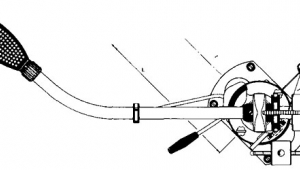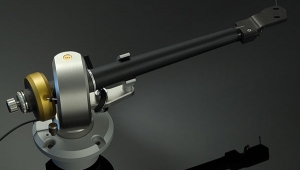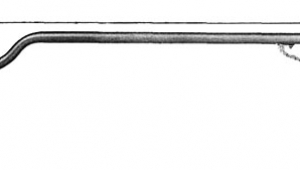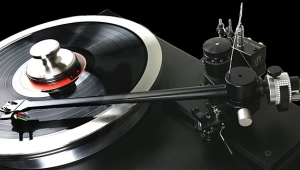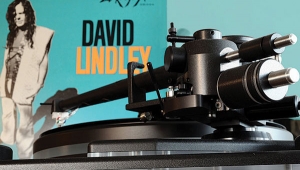| Columns Retired Columns & Blogs |
Graham Model 2.0 tonearm Followup
Michael Fremer wrote a Followup in January 2001 (Vol.24 No.1):
When I reviewed the SME 10 turntable in April 2000, I was frustrated that I couldn't audition the Graham 2.0 tonearm on it. That would have allowed me to compare the SME with my reference Simon Yorke S-9 turntable, keeping the arm as a constant. It also would have provided an opportunity to compare the Graham with the SME IV.Vi arm, which Sumiko supplied me as an upgrade to the Model 10 arm.
Bob Graham now has a 2.0 adapter plate for the Model 10 'table. (He also makes armboards and adapter plates for the VPI, Linn, Clearaudio, and SME Model 20 and 30 'tables). It is, as you might expect, nicely machined from aluminum and uses the same blue-rubber damping material found in the arm's headshell to damp the plate/'table interface. It took only a few minutes to secure the plate and about the same amount of time to install the arm, though you can't just plop it down and screw it in. You have to get the distance from the pivot point to the spindle exactly correct by using the little plastic jig Graham supplies with the arm, and which fits over the spindle and into the hole in the headshell. Luckily, I have spare armtubes; I didn't have to remove the cartridge to install the arm precisely.
The comparison between the Yorke and SME 10 turntables was interesting. The two unsprung 'tables had a similarly tightfisted dynamic drive that I really appreciated, but the SME sounded slightly more clean and sharp. You might not remember from the review that the SME ran ever so slightly fast (a problem that SME has since corrected); that might very well account for the difference. The SME's bass focus seemed ever so slightly tighter, and the SME also seemed to resolve slightly more low-level inner detail, which allowed reverberant fields to hang around longer and decay slightly more slowly. I thought I noticed this on Classic Records' 45rpm version of Mussorgsky's Pictures at an Exhibition (with Fritz Reiner and the Chicago Symphony).
The Yorke was slightly richer in the lower midrange and perhaps a bit warmer on top, but I thought the sound was comparable overall, if not identical. In my original review of the SME 10, I'd written that "the Yorke (on the Vibraplane active isolation platform) was somewhat richer in the midbass and thus slightly more mellow overall. The SME combo was clearly more dynamic, punchy, and present." That's about what I heard with the Graham arm on both 'tables, though the sound wasn't identical. As I wrote in the original SME 10 review: "If this 'table/arm combo has a weakness (I'm grasping here), it's that its focus, clarity, and transient authority come at a small price: a slight hardness and 'skeletal' harmonic quality from the midbass to the upper midrange, something your choice of cartridge can probably work around." I found that to be true, holding the arm as a constant.
What isn't comparable is the price. The SME 10 with Model 10 arm costs $6000. The Yorke S-9 with Yorke arm and Vibraplane (the package sold in the US) is $11,000. Add a few grand for the Walker Phono Drive that I used during the shoot-out and you have a pretty big price difference. Is it worth the difference to own the Yorke? These are decisions to be made by those lucky enough to afford either or both.
The Graham 2.0/SME IV.Vi Shoot-Out: Finally, I got to hear both tonearms on the same turntable with the same cartridge (Parnassus D.C.t). I was surprised: though I didn't spend "full review time" on this comparison, the results contradicted part of my SME 10 review.
The SME IV.Vi produced superb deep bass but more midbass than the Graham 2.0. This had both positive and negative effects. The negative was a slight warming that seemed to put a light blanket over the midbass region, and gave the overall sound a warmth that was pleasing but a bit mellow. The positive was a great sense of weight and solidity, and an enlargement of the soundstage in terms of both width and depth. The Graham was somewhat leaner in the midbass, which gave the overall picture a more open, detailed sound, though events seemed to occur more on isolated islands than as part of a coherent whole.
The Graham's deep-bass extension and control were outstanding. In fact, these are two great arms; which sounded "better" depended upon the recording, and certainly would be greatly affected by the choice of cartridge. There was a synergy in the SME/SME combo; the SME on the Yorke, with the arm's greater warmth and richness, would probably not be an ideal combination. The slightly leaner SME 10 made a more appropriate platform for the IV.Vi.—Michael Fremer
- Log in or register to post comments


